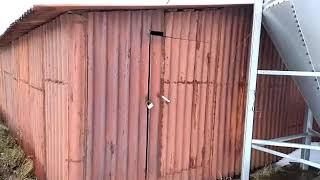
Backcountry Flying Series Episode 1 - Spot Landings
Комментарии:

Very informative video and well done!!
Ответить
Nicely done and very informative. As a local backcountry flyer, I look forward to more of these videos. Thanks!!
Ответить
Hey all, there’s sometimes some confusion surrounding the portion of the video discussing “apparent impact points” and “aiming points”. I wanted to post an email I sent to a viewer who reached out regarding this topic, I hope it can help clear up any confusion.
“Thanks for reaching out! You are correct that when the spot goes away from you, you should add power and vice versa. This will get you pretty close to hitting a point but to really nail it consistently I teach a slightly different method.
There are two “points” that we need to focus on.
1-The apparent impact point - look down at the ground as you are on an approach. Do you see a point that it looks like you would impact if you changed nothing and continued flying the aircraft just as you are into the ground? This is the apparent impact point and this is the point we can control. When we reduce power this point moves towards us, when we add power It moves away.
2-The aiming point- this is our “target” or what you referred to as the “spot” in your email.
So our goal is to put our apparent impact point right on the very beginning of our aiming point. Focus on where you would hit if you continued down your approach path with no changes, if it’s farther down the runway than your “aiming point” or the “spot”, the reduce power to bring your apparent impact point back to the spot - and vice versa.
This is a slightly different mindset than the typical strategy where you focus entirely on the relative movement of your aiming point, but I’ve found it produces much more consistent spot landings.”

Just found this. Subscribed and shared!
Ответить
Just found your Chanel. Great content and good graphics. Nicely done.
Ответить
Hi, thanks for this Vid! What camera or action cam are you using inside the cockpit? Nice Vid, very informative! tyi.
Ответить
Thank you, nicely don, looking for more...
Ответить
Great video!
Ответить
Well done!
Ответить
Watch the entire series. Great job.
Ответить
Cool. Now any Richie Kid can do this by watching yt lesson. Fly Icon(ic) 🤣
Ответить
This is amazing. Thank you for all the tips
Ответить
Great video. Thanks from Canada.
Ответить
Great video. Thoughts on an AOA indicator?
Ответить
I wish I could give you a hundred upvotes. This level of depth and the focus on real world bush plane flying is sorely missing. Thank you and keep up the focus. I hope your channel thrives.
Ответить
Excellent description
Ответить
Appreciate the content 👍
You have a new subscriber

Really cool video interesting video Thanks for the info.
Ответить
You have a very good short field landing technique. I use a similar technique as your x and red box apparent relationship. The same thing was observed and taught by Wolfgang Langewiesche in "Stick and Rudder" on the top of page 304. "The clue to watch is the intended landing spot and the scenery beyond it and to the sides of it. Once the normal glide has been broken, the process of stalling the airplane down can be gauged entirely by watching the spot and the perspective in which it appears and its apparent motion." Stromberg carbs flooded fairly easily in his day so no power/pitch, which makes his stall down very much more difficult. He said only experienced pilots did it. With power/pitch, the technique if much easier than the round out and hold off where the pilot becomes a passenger trying to control both approach angle and airspeed with elevator. Basically no descent rate control at all. The Army and I call it the apparent brisk walk rate of closure approach. If you notice way back on the approach or even in your auto at a distance to the desired touchdown spot (stopping point in your auto) we appear to be approaching the spot at a brisk walk. That apparent rate will increase drastically as we get closer (1/4 to 1/8 mile.) By using elevator, as you say, to decelerate and power, as you say, to direct our approach angle to the spot, we keep the rate of closure appearing to stay at a brisk walk. We use elevator to prevent the apparent rate of closure from speeding up. This of course causes the sink rate you have at a higher altitude with your wing angle to horizon technique. For both of us, this causes a need for power to control sink rate and maintain the approach angle down to the spot. Gust balloon and sink is also dealt with using dynamic throttle. If we have to pull power to round out over the spot, we are going too fast. When done well, variable power will be used to touchdown slowly and softly. Your technique gets the slowly quite well. Try a bit more deceleration coming into ground effect (no we do not stall at Vso in ground effect, especially low ground effect.) Vso has to do with stall out of ground effect and is much faster than the airspeed at which the wing will fly in ground effect.
Again, you technique is excellent and will work for nearly all single engine trainer type airplanes. Try stopping that apparent rate of closure from speeding up on short final and eliminate the little bounce on the big tires. You won't have to mess with the flaps, but you will have to cut power at touchdown. I know you want to brake for competition, but absolutely not necessary even on an angle across a big runway from the downwind corner to the upwind big airplane touchdown zone white square in a crosswind. At Vso, even a very slow Vso, you are going to have to pull power to keep the glide angle going into the spot. When a bit too fast to stall in one inch ground effect, there will be a bounce.
Anyway, eliminating the difficult round out and hold off technique, except for powerless spot landing practice, is certainly a move in the right direction. And using the apparent rate of closure to decelerate, even without power, will mitigate the horrible statistic that most forced landings touch down more than halfway down the available landing site.

Good vid. Thanks.
Ответить
Do you hold pitch attitude as you vary power? Or do you adjust pitch in attempt to keep the speed constant?
Ответить
Coolest chanel
Ответить
Excellent details and information. Fantastic: superior instructions!
Ответить
Dear Lucas if I want to flight on my FS2020, these flighs how can I get the track? Thanks
Ответить
Brand new pilot here that wants to start flying oz (been to trigger gap once). Nose high approach sounds scary never having done it.
Ответить
I’m a retired 70 year old flight simmer. Life events caused me to stop about 12+ years ago, but I resumed my passion about 18 months ago, although this time I’m on an Xbox console which leaves me time to be a grandpa and a virtual pilot 👍🏻 Backcountry stick and rudder flying consumes most of my time, followed by searching for locations to fly and finding resources to help me learn. I’ve found lots of those resources and some really good ones too, but just wanted to tell you that your short 5 part series is hands down the best of all the rest. Thank you for sharing them!
Ответить







![ЭТО ДОПОЛНЕНИЕ УНИЧТОЖИЛО READY OR NOT? - Home Invasion DLC [Полный Обзор] ЭТО ДОПОЛНЕНИЕ УНИЧТОЖИЛО READY OR NOT? - Home Invasion DLC [Полный Обзор]](https://invideo.cc/img/upload/ZzRIRkJYWi1Ma3g.jpg)

















